GRASS Location Wizard: Difference between revisions
⚠️Wenzeslaus (talk | contribs) (→Graphical Location Wizard: after wizard session is always started) |
|||
| Line 17: | Line 17: | ||
[[Image:Grass64 location wiz3.png|500px|thumb|center|GRASS Location Wizard: finishing the creation of the new location]] | [[Image:Grass64 location wiz3.png|500px|thumb|center|GRASS Location Wizard: finishing the creation of the new location]] | ||
After location is created successfully, GRASS GIS session is started. If you generated the new location from a geocoded raster (e.g., GeoTIFF) or vector file (e.g. SHAPE), you are asked if you want to import the map. | After the location is created successfully, the GRASS GIS session is started. If you generated the new location from a geocoded raster (e.g., GeoTIFF) or vector file (e.g. SHAPE), you are asked if you want to '''import the map'''. Doing so, the default region extent is set automatically and the map is imported. | ||
=== Import raster data === | === Import raster data === | ||
Revision as of 07:53, 11 September 2012
Creating a new location in GRASS
Graphical Location Wizard
The location wizard enables to create a new location in a few simple steps. It provides a number of ways to set the map projection: from a geodata file (SHAPE, GeoTIFF etc), using an EPSG code, settting parameters manually, etc.
Here an example:
First screen of the Location wizard which is found in the GRASS GIS Startup window:
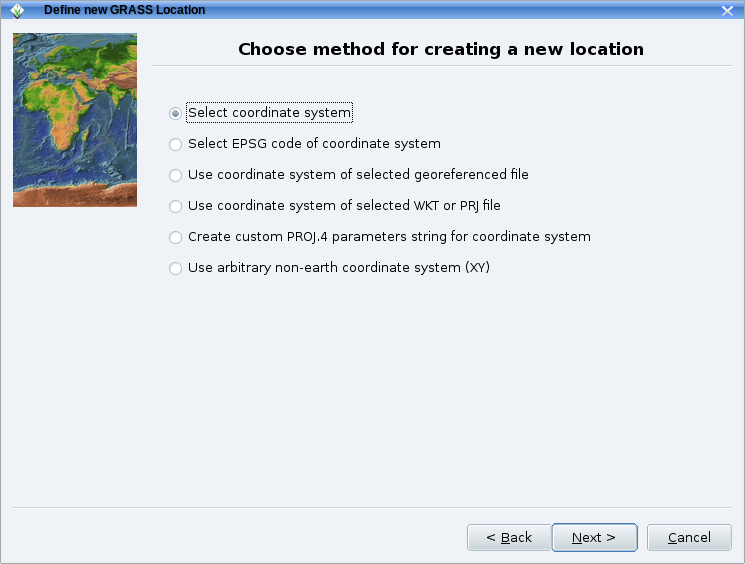
The location wizard also helps you select the appropriate geodetic datum and transform parameters for your map projection.:

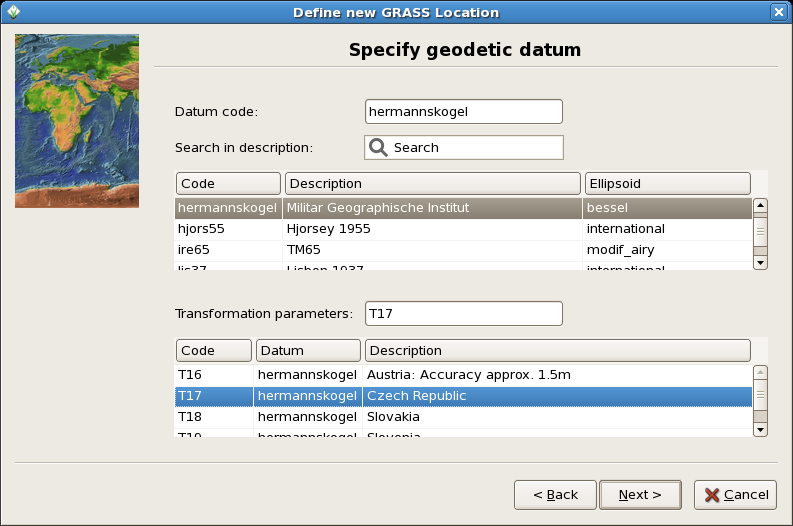
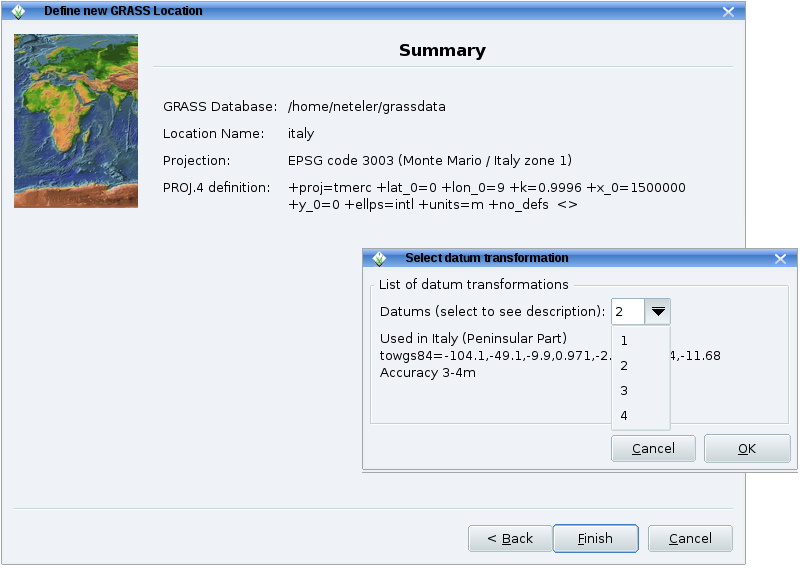
After the location is created successfully, the GRASS GIS session is started. If you generated the new location from a geocoded raster (e.g., GeoTIFF) or vector file (e.g. SHAPE), you are asked if you want to import the map. Doing so, the default region extent is set automatically and the map is imported.
Import raster data
From the main GRASS GIS menu, go to "File" --> "Import raster data" for easy raster map import.
For example, to import multiple GeoTIFF files, run:
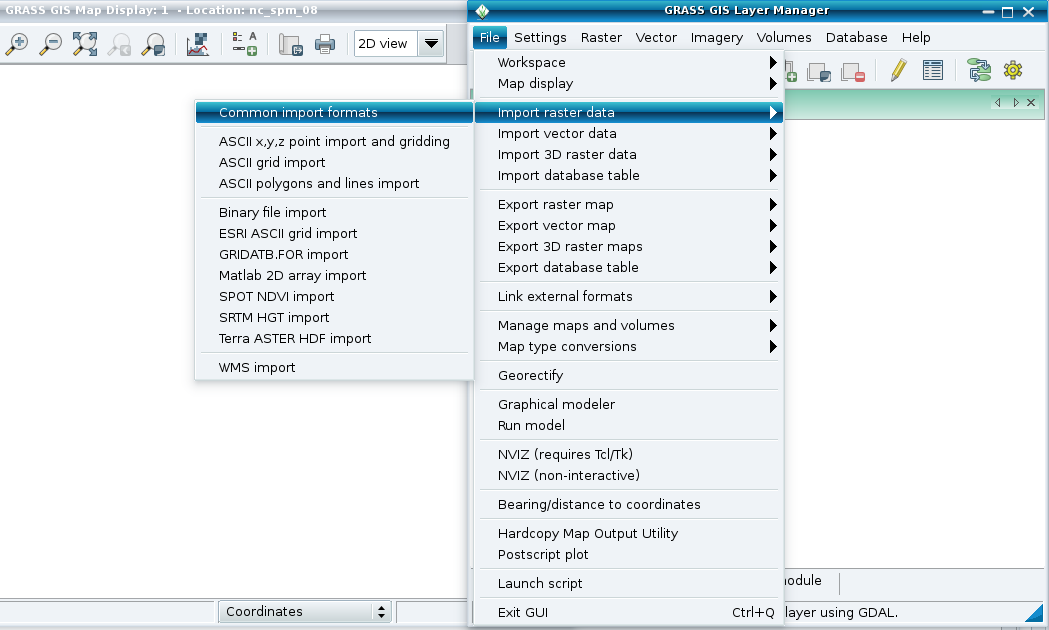 |
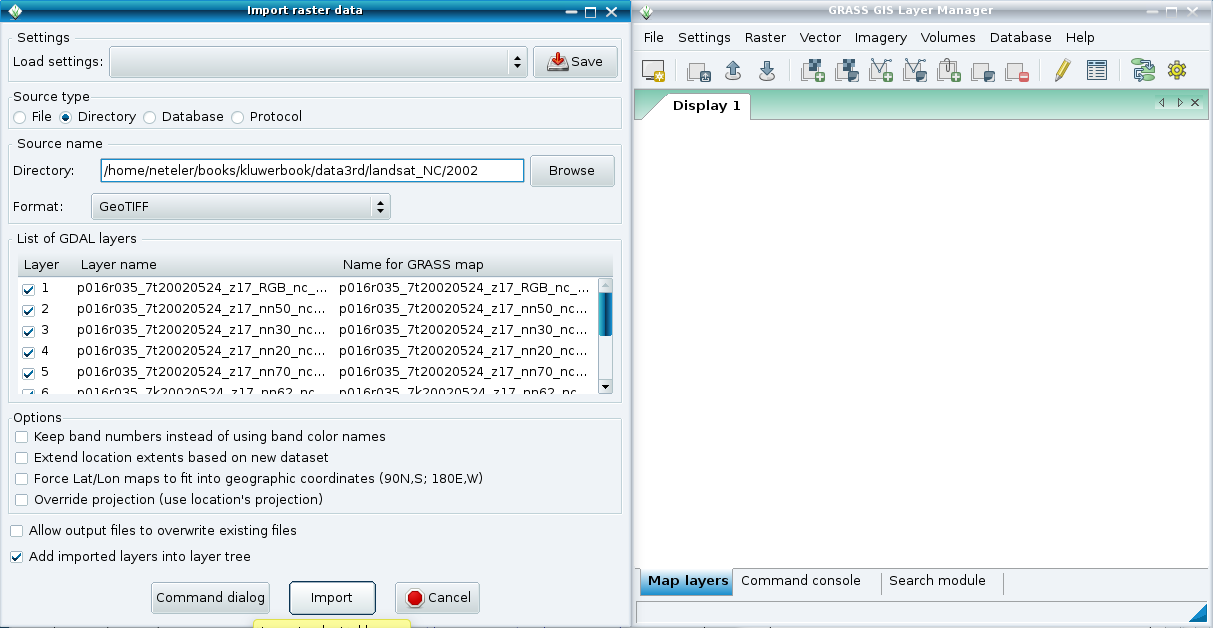 |
Import vector data
From the main GRASS GIS menu, go to "File" --> "Import vector data" for easy vector map import.
 |
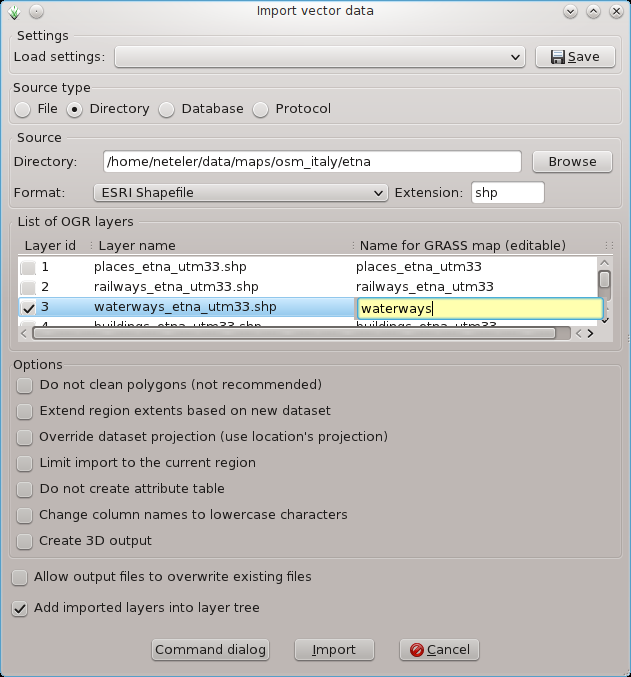 |
The usage is similar to that of raster data (see above).
Text based location wizard
When starting GRASS GIS in text mode, you can also create a new location within the terminal console.
GRASS 6.4.3
DATABASE: A directory (folder) on disk to contain all GRASS maps and data.
LOCATION: This is the name of a geographic location. It is defined by a
co-ordinate system and a rectangular boundary.
MAPSET: Each GRASS session runs under a particular MAPSET. This consists of
a rectangular REGION and a set of maps. Every LOCATION contains at
least a MAPSET called PERMANENT, which is readable by all sessions.
The REGION defaults to the entire area of the chosen LOCATION.
You may change it later with the command: g.region
- - - - - - - - - - - - - - - - - - - - - - - - - - - - - - - - - - - -
LOCATION: newLocation______________ (enter list for a list of locations)
MAPSET: PERMANENT________________ (or mapsets within a location)
DATABASE: /home/user/grassdata______________________________________________
AFTER COMPLETING ALL ANSWERS, HIT <ESC><ENTER> TO CONTINUE
(OR <Ctrl-C> TO CANCEL)
In the startup text screen enter a new location name, and then continue by pressing "ESC"-"RETURN" - i.e. press (NOT hold) the ESC key, and then press the RETURN key on your keyboard.
The you will be asked "Would you like to create location <newLocation> ? (y/n) [y]": confirm with the RETURN key on your keyboard. Now you reach:
To create a new LOCATION, you will need the following information:
1. The coordinate system for the database
x,y (for imagery and other unreferenced data)
Latitude-Longitude
UTM
Other Projection
2. The zone for the UTM database
and all the necessary parameters for projections other than
Latitude-Longitude, x,y, and UTM
3. The coordinates of the area to become the default region
and the grid resolution of this region
4. A short, one-line description or title for the location
Do you have all this information? (y/n) [y]
Confirm with the RETURN key on your keyboard.
Please specify the coordinate system for location <dewLocation> A x,y B Latitude-Longitude C UTM D Other Projection RETURN to cancel >
Next you will need to assign parameters to the location such as the coordinate system and datum you want to use, the project area's boundary coordinates, and the default resolution for raster data:
- Start by chosing between, X,Y, Latitude-Longitude, UTM, or "other" coordinate system. This choice depends on your data and the use you will make of it;
- You are then prompted for a single line of text describing the project area, for example "Topo Map of the Alps".
Next you are requested for some more information about the projection. Note that the prompts vary from projection to projection, an example follows:
- (if you chose "D - Other Projection") "specify projection name": "list" gives you the list of all available projections, examples are "tmerc" for Transverse Mercator, "lcc" for Lambert Conformal Conic, "moll" for Mollweide, etc.;
- specify datum name: again use "list" to get a list of available datums, examples are "wgs84", "nad27", "eur79", etc.;
- Enter Central Parallel: 0 if you want the Equator as the central parallel;
- Enter Central Meridian: 0 if you want the Greenwich meridian as central meridian;
- Enter Scale Factor at the Central Meridian;
- Enter plural form of map units: for example, meters .
The next step is the description of the project area's boundary coordinates and the definition of the default raster resolution:
The default raster resolution (GRID RESOLUTION) has to be chosen according to your needs. Generally, it is advisable to work in steps of 0.25 (0.25, 0.5, 1.75, 2.00, 12.25 etc.). This resolution does not concern vector and site data since these are stored with their exact coordinate values. Note that every raster map may have its own resolution. You can leave this screen with "ESC"-"RETURN" and then if everything is correct accept the list of parameters that appears.
You will then be back to the startup screen to enter the mapset's name (if not already entered). Another "ESC"-"RETURN" will finally let you leave this screen. This mapset is created within the new location by answering "yes" to the next question. The mapset will use the parameters of the location (such as the region and resolution definitions) as its default parameters.
Now the project area, i.e. the location including a mapset, has been created. You have "arrived" in the GRASS GIS system and can start working within this new location.